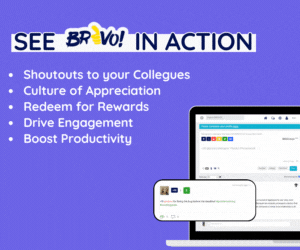
In the last ten years, the way we reward employees has changed dramatically.
It is due to the United States’ slow wage growth that has forced employers to come up with new ways to build a strong employee value proposition and differentiate themselves as preferred employers.
It’s also because employee expectations and behaviors have changed – instead of staying in an organization for decades, the average tenure in the United States is now between 3-5 years.
In general, most of the organizations focus on recognition more, but that does not take away the importance of employee rewards.
Why is reward such a vital part of today’s incentive and recognition programs?

Strategic recognition is combined with well-considered and efficiently delivered awards, which successfully increase culture and engagement while also delivering a valuable RO (return on investment).
According to Josh Bersin’s research on High Impact Performance Management, in comparison to 38 percent of firms with recognition-only programs, 57 percent of those with outstanding financial performance had a program including reward as well as recognition.
It indicates that having a strategic recognition program improves corporate performance, but combining incentive and recognition increases the likelihood of making an impact.
Let us explain how modern employee rewards have evolved in recent times.
Modern Employee Reward Programs offer Employees a Choice

Allowing for choice is critical because sometimes providing a reward that does not resonate with the individual might have the opposite effect on participation – it can even be perceived as demeaning or rude.
It could be a garment that is many sizes too large (or too tiny! ), a bottle of wine for someone who does not consume alcohol or a seafood supper for someone allergic to shellfish.
Moreover, we frequently hear stories of employees who have received an impersonal or impractical incentive, and they do not feel fantastic afterwards!
Maintaining a database of individual preferences is not always feasible or scalable for large enterprises.
Many clients assign a dollar value to various business awards in their employee recognition formula and allow employees to redeem those incentives at hundreds of online and brick-and-mortar merchants.
Allowing employees to spend their cash reward the way they like not only provides them complete autonomy but also assures that the reward is relevant and meaningful to the individual, without incurring the overhead of holding reward options or stock in-house.
And, while this is beneficial to employees, it is also beneficial to human resources.
Now, you can give meaningful awards without putting program managers through the wringer (or wasting endless hours).
To offer an exceptional employee experience, BRAVO! comes with an extraordinary set of features.
Read More: 5 Employee Recognition Programs to Strengthen Your Own
Modern Employee Rewards are Easily Deliverable

Modern incentive programs are meant to reflect the on-the-go nature of today’s employees.
They recognize people who have embodied your company values and contributed to achieving your mission in real-time, in a meaningful and positive way.
Additionally, it entails delivering instant redemption of prizes.
Modern Employee Rewards are Transparent and True to Value, and they Contribute to the Development of a Culture of Recognition

One of the primary impediments to successfully establishing a modern rewards program is the risk associated with the reward and recognition budget — companies do not want to see their investment eroded by fees and charges.
Modern rewards programs provide full face value for awards, providing managers with comprehensive visibility and control over the reward budget, as well as the freedom to recognize employees whenever they merit it.
When reward providers operate under a commercial model that requires a minimum spend or charges administration, processing, or delivery fees for each award, managers are less motivated to provide employees with the timely rewards they deserve at the moment.
This dampens the desire for immediate, on-the-spot gratification and recognition.
Having a transparent, simple-to-understand system gives managers complete control over costs, which makes it easier to foster a culture of reward and recognition.
Conclusion:
Employee rewards have evolved significantly over the recent years.
The main reason for its evolution was the incapability of past organizations to reward employees suitably. And employee retention rate decreased as a result.
However, in modern times, companies have realized the importance of employee rewards. The companies focus largely on employee rewards and recognition.
As a result, the employee retention rate is higher, and the businesses are growing faster than ever.






